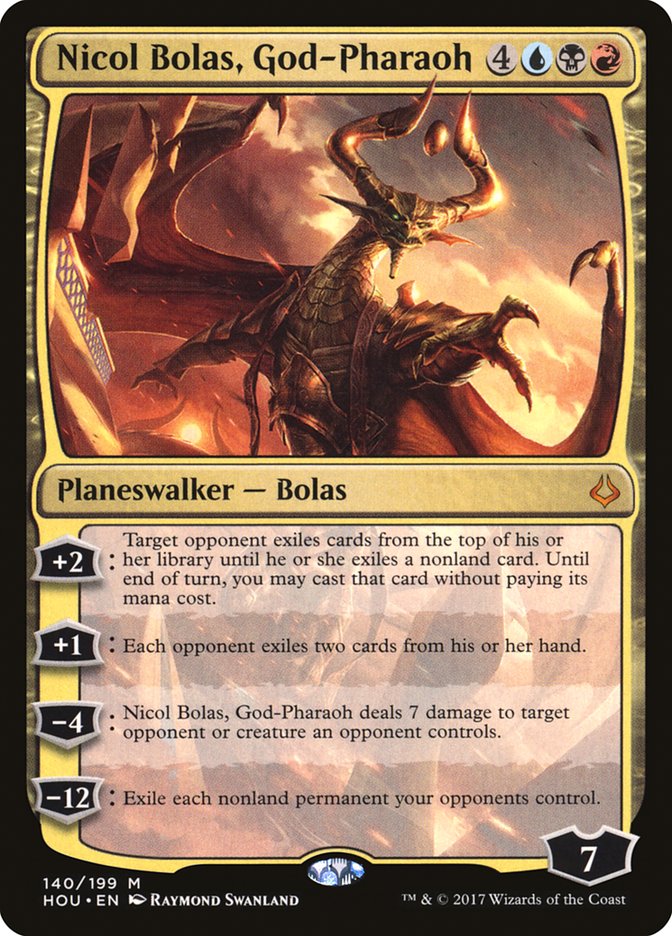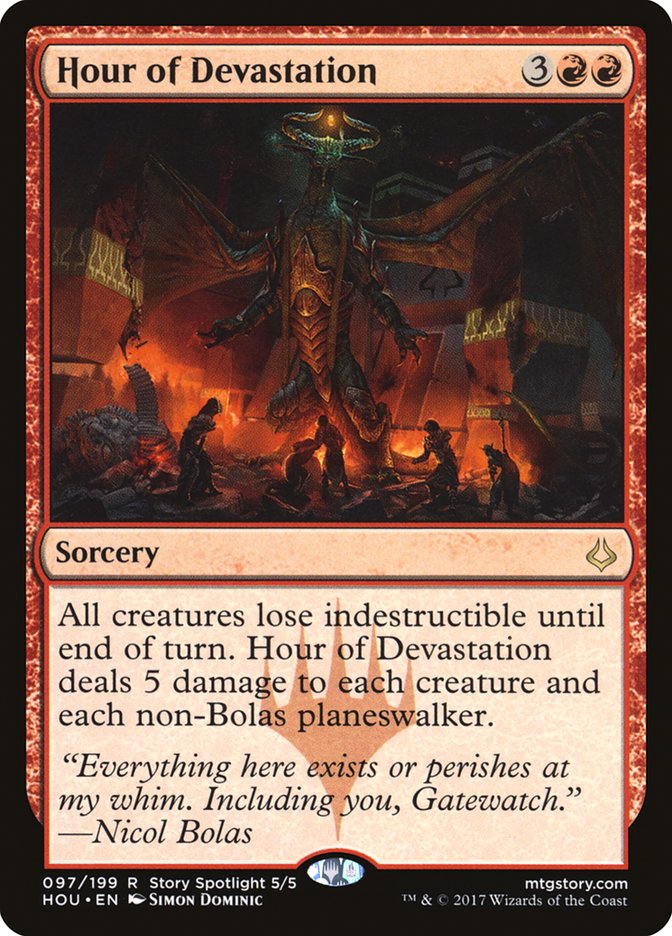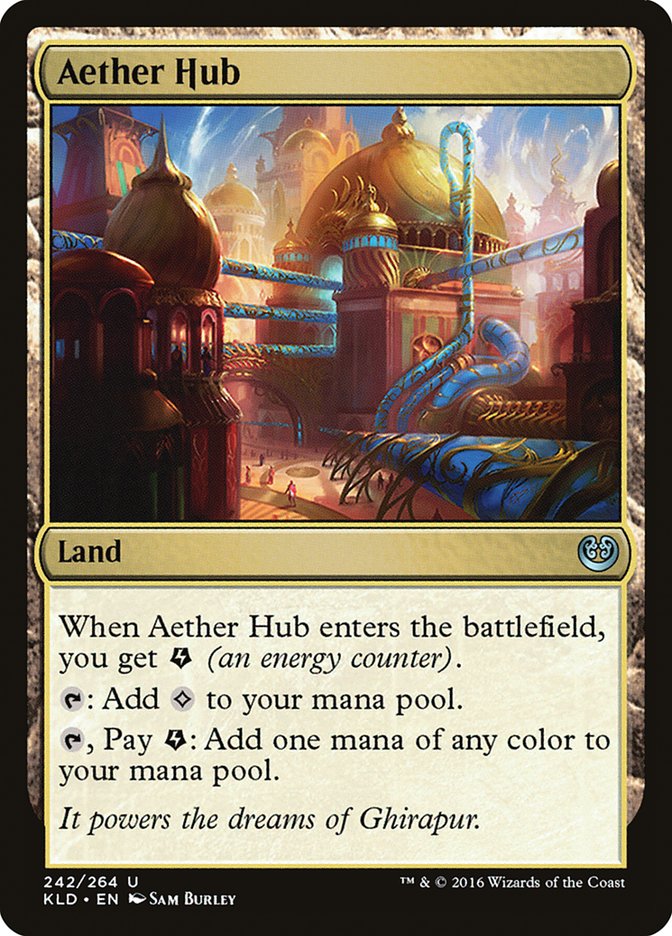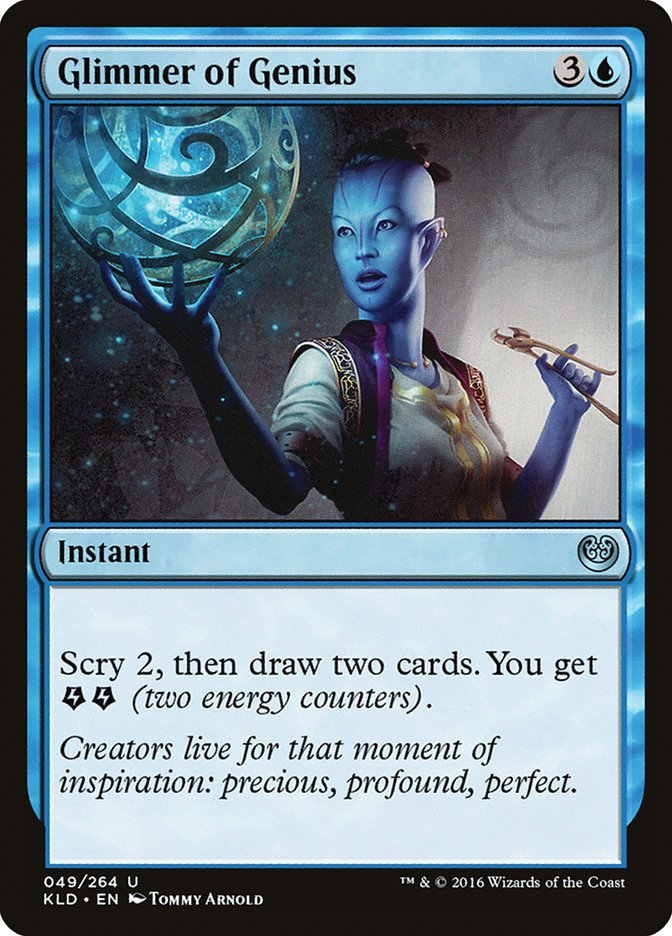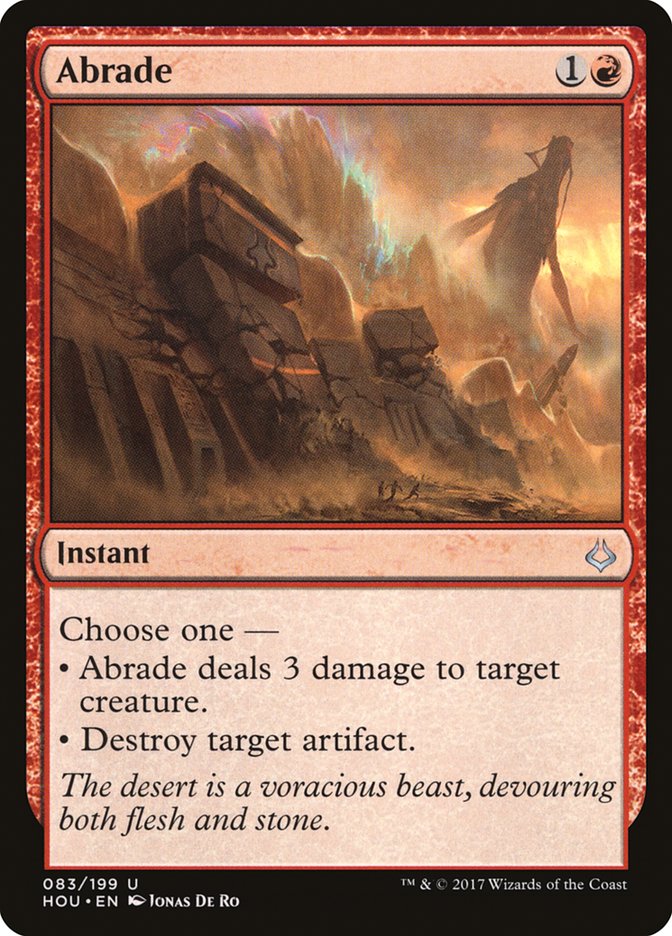Last week I discussed my ten favorite Hour of Devastation cards for control’s Standard future. After the initial wave of testing, most of the cards I listed will support some form of control that fits your style of play. There is a real chance that Esper or U/B Control has the tools to rise to the top of the format, but my desire to play Nicol Bolas, God-Pharaoh must be satisfied.
Once that card was previewed, I knew that my first run at the new Standard format would call upon the Grixis shell. There are multiple ways to draft a Grixis Control deck, which makes the testing process fairly time-consuming. Blue is the go-to control base color, but as the counterspells get weaker and the creatures get better, it has become more difficult to build around the legendary color. There have been past formats where blue was a support color, so that is one possibility after the release of Hour of Devastation. The list we are looking at today will give blue the benefit of the doubt, enlisting multiple copies of Disallow and an armada of cyclers which require a blue source in the earliest turns. The secondary color, in my opinion, has to be red. Red has provided us with the best battlefield cleanser that we’ve seen in quite some time.
My old friend Gabriel Nassif said on Twitter that there is a slight possibility that it could be banned in the future. I do not share his sentiment on the card’s future legality, but I do recognize that it may singlehandedly return these fringe control decks to the forefront of the format. I know that many of my articles before new sets are released discuss control’s viability and what cards can save the endangered Standard archetype, but this Wrath effect is as good as advertised.
U/R Control, as well as the less popular types, could fall devastatingly behind if the blue cards didn’t line up perfectly to an opponent’s threats. That issue could sometimes be resolved with a well-timed Sweltering Suns, but not against every deck and/or situation. B/G provides gigantic creatures that traditional red removal spells couldn’t defeat, Zombies could Anthem out of range, and a planeswalker hitting the battlefield resulted in imminent death in most instances.
Hour of Devastation solves the issue of falling behind, just as Hour of Revelation does, but white is harder to craft. Not only is Nicol Bolas, God-Pharaoh off the table, the removal is very conditional. Destroying attacking creatures, locking away threats in flimsy enchantments, and lacking instants/sorceries for Torrential Gearhulk to utilize are all marks against white’s viability. Due to the weakness in the white spell suite, black makes a great base to help carry the slack.
I took a stab at creating an Esper Control list for the fans out there, but I am not confident that it is equal in power level to Grixis. The last control shard is Jeskai, which I don’t think is a great option for the upcoming Standard. The only way I’d run a control deck with white is if I want access to Hour of Revelation. If not, then the spells of white are significantly weaker than those of red or black.
Let’s discuss Grixis, the flagship control deck.
Creatures (3)
Planeswalkers (1)
Lands (25)
Spells (31)

The first thing you may notice is the short supply of black sources. This is essentially a U/R deck that uses energy to produce black for the only two cards that make it Grixis. Aether Hub is one of the best mana-fixing lands printed in a very long time. It is essentially a painless City of Brass in Standard, which makes splashing that much easier. If you wanted to play a true Grixis Control deck with a diverse spell selection from black, red, and blue, you’d have to play far too many enters-the-battlefield-tapped lands. That will be one of the issues with the Esper Control deck that we look at momentarily. The rest of the manabase is straightforward, mimicking U/R Control prior to Hour of Devastation previews.
Most of the deck is carbon-copied, but the important changes lie within the win percentages. U/R Control has improved matchups across the board on the back of its new battlefield control card, Hour of Devastation. I wasn’t shy about the amount of copies in the main and I originally ran the full set. There are matches that have come down to casting them back-to-back; sometimes it’s a must-have on turn 5 to survive. When most foes require a series of battlefield wipes, the spell count should be at least three.
Many of us make that mistake when building control decks. Packing just two ways to reset the game when behind is foolish when there are so many aggressive decks that are prime for a breakout. Monument decks flood the battlefield with Gideon, Ally of Zendikar as the finisher. Their control-killing card, Spell Queller, doesn’t do the trick against this expensive sorcery. B/G Energy / Constrictor can do a similar number on an unsuspecting control opponent. An early Winding Constrictor got you down? Nissa, Voice of Zendikar snuck out there and your afternoon was almost ruined? The red Wrath of God can handle both problems.
The price that we pay is losing our reactive nature. U/R Control is famously blue-heavy, which isn’t the case now. Negate isn’t a card that can be used maindeck in the upcoming Standard, and red cards are required for survival. This makes for fewer nut draws with perfect blue spell after perfect blue spell lining up and more clean-up after some damage has been taken. U/R Control must sacrifice the flash element and fight dirty.
The blue spells in the deck haven’t changed much, but there are a lot of options from Hour of Devastation that I want to get in the lineup. Censor, Hieroglyphic Illumination, Magma Spray, Essence Scatter, and Harnessed Lightning all provide the early-game answers to have a brief window to cast Glimmer of Genius. The result is hopefully a clean battlefield due to your removal and counters, or at least a nice Hour of Devastation to dash your opponent’s ambition. Most of the games that I have played have ended in this scenario.
This version of U/R Control will be weaker in the mirror because I have accepted the cold reality of blue’s shortcomings. I’d love to play all blue spells, three Hour of Devastation, and a couple of Harnessed Lightnings, but that isn’t how the world works these days. Magma Spray, Harnessed Lightning, Hour of Devastation, Dynavolt Tower, and even Essence Scatter can be mediocre in the control mirror. This sacrifice is warranted by the improvements across the metagame board. Dynavolt Tower is a control card that hasn’t seen play in a while. It’s a great outlet for all the energy counters U/R Control players waste game after game, as well as a reusable removal spell.
Nicol Bolas, God-Pharaoh has been getting a lot of heat lately from the critics. I’m not sure what people expected of this planeswalker, because it’s close to its former self. The card is slow, doesn’t kill multiple threats upon arrival, and produces massive card advantage. Those are the stats of a planeswalker that is amazing against midrange and control decks. The criticism I’ve seen is that its bad against this fast deck, or that aggressive deck.
That is obvious from the inception of the card.
The one copy in the main deck has pulled its weight. It’s a card that I’d like to draw later in the game due to the mana cost, but it’s not necessary on turn 7. I even added a little flavor singleton, Dark Intimations, which has overperformed heavily. This spicy number gives U/R Control an Edict effect against Bristling Hydra and Sphinx of the Final Word. Both of those cards have been huge thorns in my side, and I’m very happy to be able to run an effective answer in the maindeck. For five mana, the Edict comes with a three-card advantage swing. Returning a fallen Torrential Gearhulk Game 1 or a Dragonmaster Outcast after sideboarding has been great. It reminds me of the U/B Control win condition reach that Liliana, the Last Hope provided. There are times where the Torrential Gearhulks are worn down and this rebuy gives the game right back to the control hero.
The sideboard has also been heavily improved with the new set. Abrade is the card I’m most excited about. I still enjoy a copy of Release the Gremlins to keep artifact users honest, but Abrade is a much stronger card. Instant-speed artifact removal for red was oddly absent from Standard until now; I tried to think back to a format with Shatter and I was unable to do so. It’s an effect that we should always have and now the world is right once again. The second effect on Abrade is nothing to shake a stick at, saving the user from the threats behind the Vehicles if need be.
Since Hour of Devastation carries the banner for mass removal, the sideboard is filled with the older options. Chandra, Flamecaller is still a great card to bring in when more win conditions or battlefield destruction is required. It’s one of the more versatile sideboard cards because of how good it is against aggressive, midrange, and control decks. Sweltering Suns serves a much more specific purpose. Zombies, Monument, and Temur decks all have a low-to-the-ground assault that requires an answer before turn 5. Sweltering Suns has cycling attached in case the sweeper count in hand gets too high as well. Each mass removal spell in this U/R Control deck can be used to obliterate an opponent’s assortment of creatures, attack their planeswalker, and/or produce raw card advantage. It isn’t the traditional four-mana answer anymore for us control enthusiasts, but it’ll do.
I mentioned that I tinkered with Esper Control but was not happy with the result. The removal in black is powerful; Liliana, the Last Hope still yearns for a control shell; and Hour of Revelation has one of the most potent effects in Standard. The issue is still the mana of Esper Control and the embarrassingly low count of quality white spells. I love Cast Out and Stasis Snare, but these types of removal spells can’t be played in a deck with the three mandatory copies of Hour of Revelation I’d play. The mana cost has a triple white requirement, which prevents U/B Control from “splashing” it as the late-game haymaker.
If U/R Control fails me miserably during Pro Tour testing, I will do everything in my power to generate a control deck that utilizes the full potential of Hour of Revelation for future events. It’s a card that should see play due to its power level, and I hope that we as a community can figure it how.


